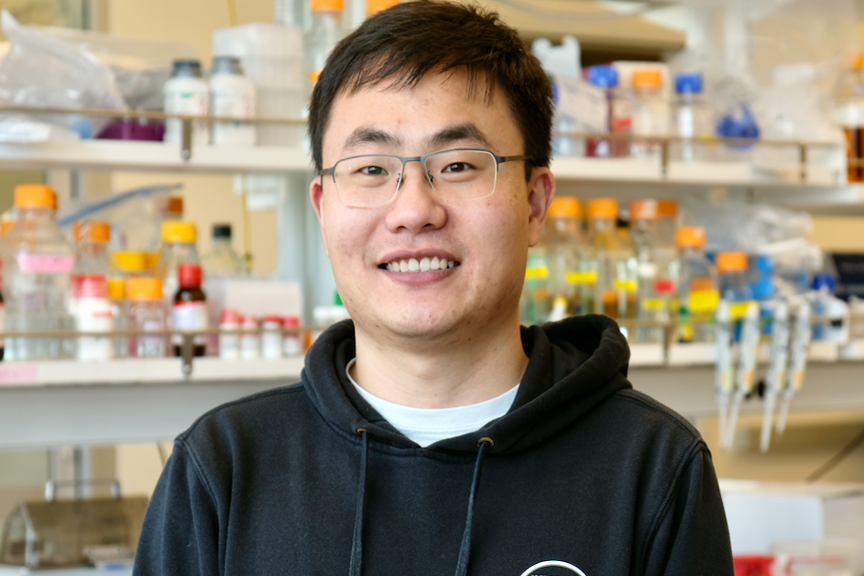人物經歷
曹龍興(1990-),山東巨野縣人。2012年畢業於山東大學生命科學學院,獲學士學位。2012-2017年在中國科學院生物化學與細胞生物學研究所攻讀博士學位,從事利用結構生物學手段對細胞表面受體進行結構和功能的研究。2017-2021年在華盛頓大學蛋白質設計研究所進行博士後研究,致力於蛋白質設計方法的開發與套用。曹龍興博士將於2021年8月全職加入西湖大學生命科學學院,擔任研究員、助理教授(獨立PI)一職,繼續從事蛋白質設計領域的相關研究。
學術成果
蛋白質設計是合成生物學的重要分支和新型前沿科學,人工設計的,具有全新結構的和全新功能的蛋白質,將對生物醫藥,尤其是精準醫療領域產生深遠影響。曹龍興博士一直從事蛋白質設計方法的開發與套用:1,開發了可針對自然界任意蛋白質設計全新結合蛋白的計算方法,並利用該方法設計了一系列具有高親和力和穩定性的可結合病毒受體,重要細胞表面受體等的全新蛋白質;2,設計了皮摩爾親和力的可結合新冠病毒棘突蛋白並抑制病毒感染的全新蛋白質(LCB1),動物模型中的測試結果表明LCB1可高效保護實驗動物免於病毒侵染,並已準備開展臨床實驗;3,探索深度學習方法在蛋白質設計中的套用,開發了基於深度神經網路的蛋白質序列設計方法。
蛋白質設計技術是一類顛覆性技術,具有巨大的套用潛力和價值,正在改變蛋白質藥物研發的未來趨勢。實驗室將基於對蛋白質摺疊與相互作用的基礎性科學研究,開發蛋白質設計新方法,並探索全新設計蛋白在精準醫療領域的套用。實驗室研究方向集中於(但不限定於)以下幾個方面:
1,針對重大疾病相關的靶點蛋白及免疫調控受體設計結合蛋白, 開發基於人工設計蛋白質的新一代智慧型蛋白質藥物。
2,設計可用於體內實驗的光控型蛋白質二聚體,並探索其在光遺傳學以及靶向性免疫細胞療法中的套用。
3,開發基於深度學習的蛋白質設計計算方法,並設計具有更加複雜結構和功能的全新蛋白質。
代表論文
1. Cao, L., Goreshnik, I., Coventry, B., Case, J. B., Miller, L., Kozodoy, L., ... & Baker, D. (2020). De novo design of picomolar SARS-CoV-2 miniprotein inhibitors. Science, 370(6515), 426-431.
2. Case, J. B., Chen, R. E., Cao, L., Ying, B., Winkler, E. S., Goreshnik, I., ... & Diamond, M. S. (2021). Ultrapotent miniproteins targeting the receptor-binding domain protect against SARS-CoV-2 infection and disease in mice. bioRxiv.
3. Cao, L.*, Yu, B.*, Kong, D.*, Cong, Q., Yu, T., Chen, Z., ... & He, Y. (2019). Functional expression and characterization of the envelope glycoprotein E1E2 heterodimer of hepatitis C virus. PLoS pathogens, 15(5), e1007759. (co-first author)
4 Dong, Y., Cao, L., Tang, H., Shi, X., & He, Y. (2017). Structure of Human M-type Phospholipase A2 Receptor Revealed by Cryo-Electron Microscopy. JMB, 429(24), 3825-3835. (co-first author)
5. Cao, L., Chang, H., Shi, X., Peng, C., & He, Y. (2016). Keratin mediates the recognition of apoptotic and necrotic cells through dendritic cell receptor DEC205/CD205. PNAS, 113(47), 13438-13443.
6. Cao, L., Shi, X., Chang, H., Zhang, Q., & He, Y. (2015). pH-dependent recognition of apoptotic and necrotic cells by the human dendritic cell receptor DEC205. PNAS, 112(23), 7237-7242.
7. Singer, J. M., Novotney, S., Strickland, D., Haddox, H. K., Leiby, N., Rocklin, G. J., Chow, C., Roy, A., Bera, A., Motta, F., Cao, L., ... & Klavins, E. (2021). Large-scale design and refinement of stable proteins using sequence-only models. bioRxiv.
8. Quijano-Rubio, A., Yeh, HW., Park, J., Lee, H., Langan, R., Boyken, S., Lajoie, M., Cao, L., … & Baker, D. (2021). De novo design of modular and tunable protein biosensors. Nature, 591, 482–487
9. Cheng, C., Hu, Z., Cao, L., Peng, C., & He, Y. (2019). The scavenger receptor SCARA1 (CD204) recognizes dead cells through spectrin. Journal of Biological Chemistry, 294(49), 18881-18897.
10. Chang, H., Cao, L., & He, Y. (2018). Electron Microscopic Analysis of the Plasma Membrane and Cell Surface Molecules. Membrane Biophysics (pp. 221-250). Springer, Singapore.
11. Zhong C., Shen J., Zhang, H., Li, G., Shen, S., Wang, F., Hu, K., Cao, L., He, Y., & Ding, J. (2017). Cbln1 and Cbln4 Are Structurally Similar but Differ in GluD2 Binding Interactions. Cell reports, 20(10), 2328-2340.

